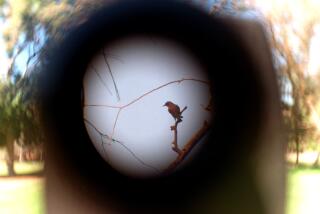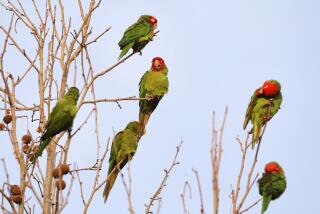Swamps, Snakes Can’t Keep Them From Tracking Flying Jewels
- Share via
LOS ANGELES — It just doesn’t figure.
Robert and Esther Quesada Tyrrell don’t seem like adventuresome types. They don’t even like to camp out.
Yet their journeys include slogging through crocodile-infested Cuban swamps, hacking through Caribbean jungles that are home to deadly seven-foot snakes and confronting machete-wielding marijuana growers in Mexico.
All this and more in search of what they call “flying jewels.”
Hummingbirds.
For 16 years, the Tyrrells have been hooked on hummers, those tiny, iridescent, acrobatic helicopters of the bird world that can hover, fly straight up, sideways, backward and upside down.
“They’re like tiny mirrors,” says Robert. “You can pluck one of their feathers and there’s no color at all. They really are like jewels, and depending where they are in relation to the sun determines what colors you see.”
The El Monte couple’s quest has resulted in some of the world’s most stunning and detailed photography of hummingbirds. Indeed, Robert is one of a handful of photographers who have taken high-clarity photographs of hummingbirds.
He has special high-speed strobes that flash 50/1-millionth of a second “to freeze the bird in flight.” (The wings of an average hummingbird beat 78 to 80 times per second.) So detailed are his photos that one shows a hummingbird with tiny pollen particles on its head; another depicts a bird spitting nectar from its long, tiny beak.
These and other spectacular photos are found in “Hummingbirds of the Caribbean,” a coffee-table sized book published last summer. It follows by six years their “Hummingbirds: Their Life and Their Behavior,” which has sold more than 100,000 copies.
In addition, they have:
* Published photographs and stories in National Geographic, Natural History, Wildlife Conservation, and both National and International Wildlife.
* Catalogued thousands of Robert’s photos of the minute birds. He is one of only three photographers to capture on film the male Bee hummingbird, which at 2 1/4 inches long and 1.95 grams in weight is the world’s smallest bird.
Despite lacking academic credentials, the Tyrrells have won the respect of ornithologists and university biologists who specialize in avian studies.
“Neither Esther (nor) Robert is trained in the field,” says Larry Wolf, a Syracuse University professor of biology and a hummingbird expert. “They’ve done it all themselves. Their books are not designed as scientific journals. Esther does up-to-date and informed research, and Robert’s photographs are really quite elegant.
“Their books are useful for the public because they attract interest in the bird with a combination of pictures and a good bit of science well done. They do a really good service presenting the spectacular nature of the hummingbird and what it is about to the lay public.”
Robert Tyrrell’s hummingbird journey began alone.
A commercial photographer in Hollywood who specialized in advertising and sports photos, he spotted a tiny gray-green hummer while sitting in his parents’ El Monte back yard one spring morning in 1975.
“Wouldn’t it be great,” he remembers thinking, “if I could photograph that bird frozen in flight?”
It proved easier said than done.
Every time he photographed a hummingbird--after putting up a feeder in his parents’ back yard--he got a sharp image of the bird’s body, but blurred wings. “Sometimes so blurry, they disappeared,” he says.
He kept trying.
Meanwhile, he became reacquainted with Esther Quesada, a former El Monte High cheerleader whom, in 1964, he had taken on her first date. After a two-year courtship, they married in 1978.
By then, Esther had begun researching hummingbirds in Los Angeles libraries. To support themselves, Robert continued his commercial photography and Esther worked as an X-ray technician and, later, as a secretary.
It took Robert, 44, six years to perfect his freeze-frame technique on hummingbirds. He got help from Harold Edgerton of MIT, the professor instrumental in developing electrical circuits to create stoboscopic light.
Edgerton, who in 1938 took the famous photo of a drop of milk making a crown-shaped drop in a container of milk, sent Robert some strobe equipment.
Robert returned it after building similar equipment. Until his death in 1990, Edgerton supported Robert’s work, calling it “about the best of hummingbirds I’ve ever seen.”
Getting the photographs hasn’t been easy.
It took 18 months just to negotiate entrance to Cuba so the Tyrrells could locate and photograph the tiny Bee hummingbird for their Caribbean book. Then they had to transport 400 pounds of photographic equipment to a swamp near the Bay of Pigs; it was filled with “screaming parrots, crocodiles, pygmy owls, vultures,” says Esther.
“Believe it or not, Castro has a very intense conservation plan there. We had to go past 10 or 15 military men, some on horseback, who were guarding the swamp. Everything in there is pristine.”
It took three weeks to complete the photographs.
Searching for the blue-headed hummer on Martinique, they hacked through miles of jungle, unaware that the area was inhabited by the Fer-de-Lance, a seven-foot pit viper that can climb trees and slither across rivers.
“We were later told that the only antidote for a Fer-de-Lance is a prayer,” Esther recalls.
And while searching for other species, the Tyrrells have stumbled upon a drug drop in the Bahamas and crossed paths with marijuana farmers in the the mountains of Mexico.
Esther, 42, remembers the Mexico encounter well: “It was early morning--that’s the best time to photograph hummingbirds. And there we were with our binoculars and cameras. Two men with machetes walked out of the woods, and they were very angry, cursing us. They thought we were drug agents.”
Although fluent in Spanish, she was so scared she could remember only one thing: Que Dios les bendiga , May God bless you. “I guess they didn’t think drug agents would stand there blessing them, and they turned around and left.”
From first-hand knowledge and research, the Tyrrells probably know as much about hummers as anyone.
They will tell you that hummers are fierce fighters, which explains why the Aztecs’ god of war is named Huitzilopochtli--a combination of two words that mean hummingbird and sorcerer who spits fire . In battle, the hummingbird’s greatest weapon is its elongated, protruding breastbone, which it uses to ram another bird. “They’re very aggressive and warlike, but they very seldom kill each other,” Esther says.
Many cultures also believe the tiny birds have spiritual and healing powers. Stuffed hummingbirds are sold in silk pouches in Mexico’s mercados ; in the Dominican Republic, hummer nests are sold as a cure for ear infections.
Hummers’ life spans range from nine to 12 years. And contrary to popular belief, they don’t suck nectar out of flowers, but “lick it out just like a cat,” Esther says. “Their tongues go in and out 13 times per second.”
Hummingbirds are quite territorial about the flowers they feed from and about their nests. Hummingbirds’ favorite color is red, Esther says, “and they will come up to your lipstick or nail polish to see if you are a food source.”
“The reason they’re on earth is to cross-pollinate flowers. The males are the most colorful. And the females lay the smallest egg of any bird. It’s the size of a coffee bean. They always lay two, and that’s over one-third of their total weight.
“That’s like a 120-pound woman carrying twins weighing about 41 pounds,” she says.
The Tyrrells readily acknowledge their lack of scientific training, calling themselves naturalists whose goal is to increase interest in hummingbirds. “They’re so special and so ignored,” says Esther.
For their books, they have traveled 80,000 miles and spent almost $90,000 of their own money. Yet even with two successful books, Esther says, they still haven’t broken even: “That’s why we live so frugally, to save money to start on our next project.”
That project will be costly and time-consuming. They are planning a four-volume work on the hummingbirds of South America, home to the majority of the hemisphere’s 339 species.
More to Read
Sign up for The Wild
We’ll help you find the best places to hike, bike and run, as well as the perfect silent spots for meditation and yoga.
You may occasionally receive promotional content from the Los Angeles Times.






